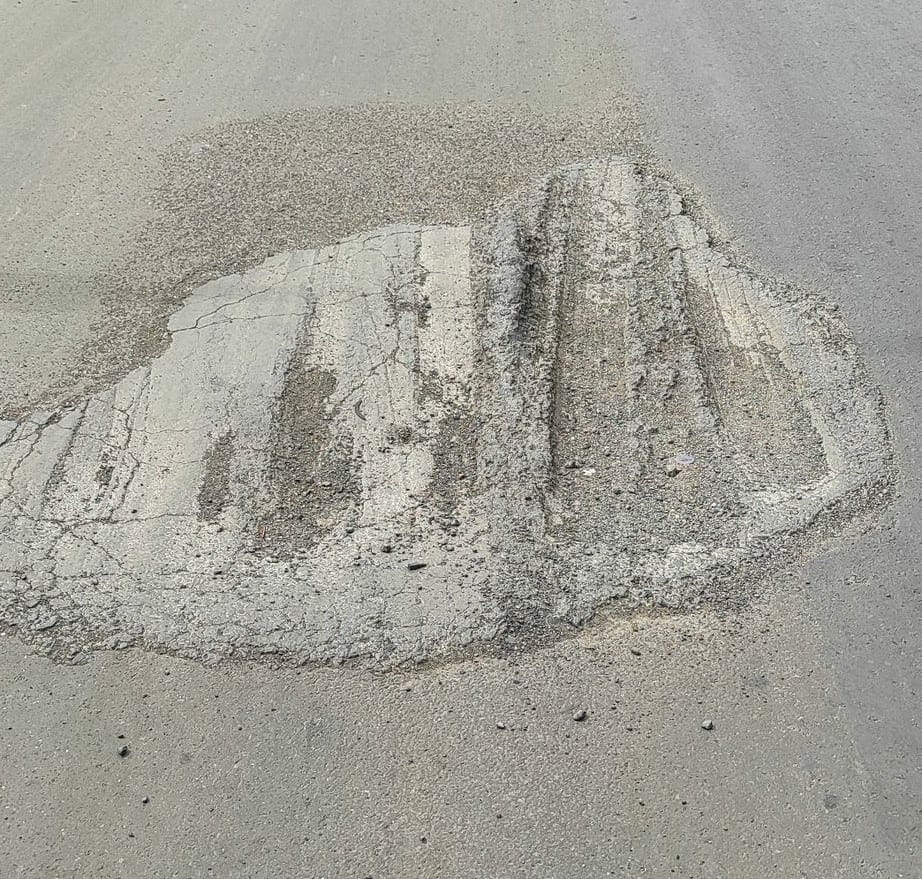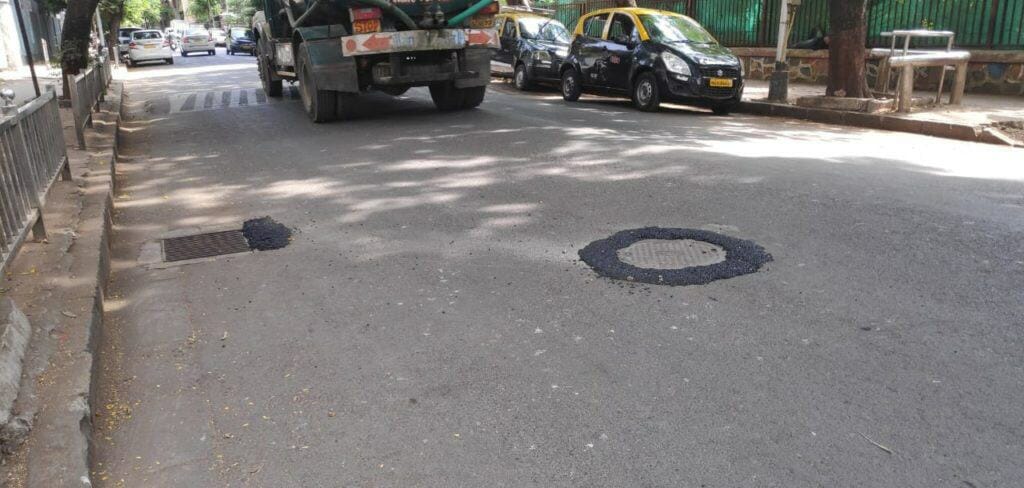Mumbai, being a coastal city, witnesses flooding in vulnerable areas every monsoon. These floods cause much damage to roads, resulting in serious road safety concerns.
According to the Maharashtra Highway Safety Patrol, between January to April, out of the total 19,383 road accidents that occurred in the state 5,333 were fatal and 9,120 people were injured. More than 45% of these were in Mumbai. The transport department attributes this to ongoing metro work and the state of roads – potholes, barricades etc.
Ahead of the monsoon season, the Brihanmumbai Municipal Corporation (BMC) is completing pre-monsoon work that will mitigate the impact of flooding – trimming trees, cleaning nullahs, desilting rivers and ponds, and patching up work to fill major potholes.
Come monsoon, potholes could be one of the biggest problems for citizens. They cause road accidents that lead to severe injuries, sometimes death.
To address this, 24 wards in the city have demanded over 3000 tonnes of cold mix to fill the potholes in their areas. Every year, people speak out against the bad quality of cold mix used to fill potholes in the rain. Many complain that it washes away, corrodes or lifts, making it even more unsafe for vehicles. Only a few months or weeks after potholes are filled, they reappear.
A BMC official told the Free Press Journal that the reason cold mix is not effective is that contractors don’t follow the correct procedure.
Pothole fixing mechanisms
Cold mix is popularly used to fix potholes. It is a type of asphalt that doesn’t need to be heated to be applied, making it ideal for patching potholes around the city. It doesn’t need much drying time and so it is preferred especially during monsoons for pothole repairs. Pre-monsoon work mostly requires the use of hot mix asphalt as it’s more durable, and has time to set in the sunlight. “However, the BMC is put under pressure to open up roads earlier than the time needed to set this asphalt. A weak foundation leads to even more potholes,” said AV Shenoy, member of Mumbai Vikas Samiti.
Cold mix was earlier considered to be an inefficient and expensive method to fill potholes as it was imported from Austria and Israel for up to Rs 170 per kg. Now, to supply the growing demand for cold mix in the 24 wards, the BMC has set up its plant in Worli that will minimise costs, making it close to Rs 28 per kg.
According to Rahul Kolhe, Senior Engineer in charge of Maintenance in the D Ward, each pothole costs between Rs 2000 – Rs 4000 depending on the size. Filling new potholes as and when they surface can be a fairly expensive option in the long run. “Concretising roads is one way to avoid potholes in the future, eventually also minimising costs,” he said.
Zone 1 in Mumbai has outsourced work to a private company to complete pre-monsoon mitigation work on roads. Speco Infrastructure is in charge of completing patch work on spots in Zone 1 that are reported by residents and activists. “We fix any bad patches on roads, be it potholes or corroded patches by filling them up and adding a top coat to make them rain resistant,” said Dhanraj Belure, an engineer at Speco infrastructure.
Despite the efforts, Mumbai continues to have poorly filled potholes. “Sometimes if the road is already too old and damaged, it is more difficult for the mix to settle evenly. These roads are more vulnerable to indentation as heavy vehicles pass over,” said Belure. Poorly fixed potholes are equally dangerous to commuters, as potholes themselves.

Raising complaints about potholes
A common practice to highlight potholes in an area is to call the respective ward. Ahead of the monsoon, the BMC usually issues a list of WhatsApp numbers of engineers in each ward. This puts people in direct contact with the person in-charge.
Tweeting about civic grievances has also proven effective. Civic activists on Twitter like Mushtaq Ansari (@potholewarriors), Mumbai North Central District Forum (MNCDF), and Sneha (@QueenofThane) tweet about potholes with images and locations. “After tweeting, the pothole or any other similar problem is fixed within 24 hours,” said Mushtaq. Having a decent following on Twitter in the civic space also raises accountability.

The BMC also has a pothole tracking mechanism that keeps record of all reported potholes and a timeframe in which they were fixed. However, this only includes potholes that the ward received complaints about. Residents say that the current pothole count is severely under-reported. “Engineers and respective authorities should scout potholes on their own instead of waiting for people to file complaints,” said Cheryll Pareira, a member of MNCDF.
In September 2021, BMC reported only 927 potholes in all of Mumbai, “which is a bizarre number if you factor in the size of the city,” she added.
Civic grievances related to road infrastructure – potholes, unkempt dividers, abandoned vehicles – are usually resolved within a day or two. “We have the manpower to fix potholes, but no active people taking charge of their own area. The more people complain the better our city will be,” said Mushtaq.
Read more: The easiest way to fix Mumbai’s potholes is to complain on Twitter
An infrastructure problem
“Mumbai has come a long way in terms of road infrastructure and civic grievance resolution. You don’t see nearly as many potholes as you did in 2014,” said Mushtaq.
Handsome budgets for infrastructure have facilitated the concretisation of roads which has significantly reduced potholes. However, some suburbs continue to have problem areas. But a fairly efficient system is in place that will fix the issue in a short period.
BMC’s Pothole Fixit app allows people to complain about potholes in their neighbourhood. When introduced in 2019, they would provide an incentive of Rs 500 to complainants if their pothole wasn’t fixed in 24 hours. This incentive has now been discontinued, but the app remains the fastest way to get potholes fixed, followed by Twitter and WhatsApp.
However, there is still room for improvement. “Google Maps must add pothole information in their Maps. So we can compare and choose safer roads accordingly. Gyroscope can help Google maps to detect intensity of potholes on particular roads” said Navi Mumbai Citizen Voice, a Twitter handle dedicated to civic issues.
According to a report by Mumbai Vikas Samiti, it was found that only concrete roads can withstand Mumbai traffic. In Mumbai, the roads have unequal widths, which creates a lot of bottlenecks around the city. It makes the roads vulnerable to potholes and wears and tear. Junctions, signals and spots where people brake a lot are also prone to potholes, along with water-logging spots.
Being a former member of the Roads, Inter-utility, Coordination and Apex committee, AV Shenoy thinks that quality assurance is key to building good roads. “Tenders are passed and bills are cleared without proper supervision of the materials and quality of labour used. Concrete paver blocks, which are very durable for roads, have a bad reputation because of the way they are usually installed, and their substandard quality,” said Shenoy.
“Contractors are supposed to adhere to the Indian Roads Congress (IRC) standards for materials and workmanship, but more often than not there is no audit of the materials,” he added.
BMC officials said that all pre-monsoon work will be finished to the best of their capacity. However, they said they cannot take full responsibility for the malfunctioning of any preventive measure, because of unpredictable rainfall patterns.